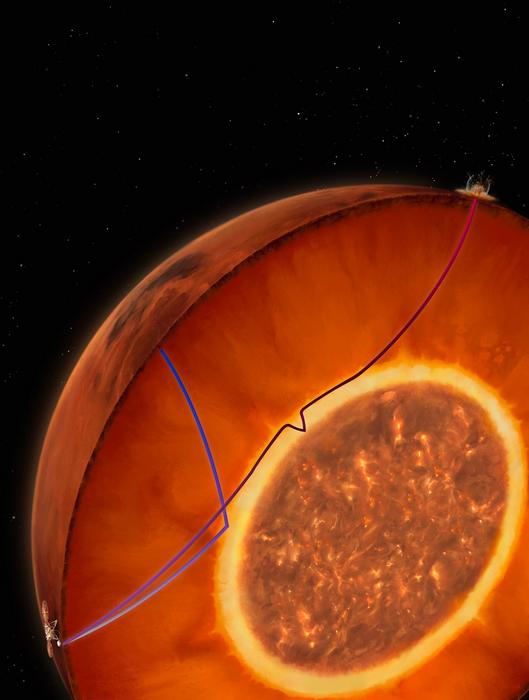Why doesn’t Mars have a magnetic field? If it did, the planet would be protected from cosmic radiation and charged particles emitted by our Sun. With a magnetic field, perhaps the Red Planet wouldn’t be the dry, barren world it is today.
It has long been believed that Mars once had a global magnetic field like Earth does, but somehow the iron-core dynamo that generated it must have shut down billions of years ago.
But new seismic data from NASA’s InSight lander might change our understanding of Mar’s interior, as well as alter the view of how Mars evolved and changed over time. InSight’s data revealed the presence of a molten silicate layer overlying Mars’ metallic core. Scientists say this insulating layer is like a blanket that might prevent the core from producing a global magnetic field.
“The blanket not only insulates the heat coming from the core and prevents the core from cooling, but also concentrates radioactive elements whose decay generates heat,” said Vedran Lekic, a professor at the University of Maryland and co-author of a new paper published in Nature. “And when that happens, the core is likely to be unable to produce the convective motions that would create a magnetic field—which can explain why Mars currently doesn’t have an active magnetic field around it.”
Earth’s magnetic field comes from its core, where molten, electrically conducting iron flows beneath the crust. This magnetic field is global, meaning it surrounds the entire planet. Even though Mars is a rocky, terrestrial planet like Earth, Mars does not generate a magnetic field on its own, outside of relatively small patches of magnetized crust.
Without the protection a magnetic field provided, Mars’ atmosphere was stripped, and eventually, any water on the surface – even oceans – would have evaporated as water vapor in the atmosphere was lost to space, making it incapable of sustaining life.

NASA’s InSight mission deployed the first seismometer on the surface of Mars. It recorded “Marsquakes,” and it has also helped determine the layering and thickness of the planet’s crust, the structure of the mantle, and the size of Mars’ core and its composition. Data from InSight is helping planetary scientists to work out the internal structure of Mars. Lekic and his colleagues say that InSIght has now revealed, surprisingly, the molten silicate layer overlying the planet’s metallic core.
Silicates are rock-forming minerals that make up the crust and mantle of both Mars and Earth. The molten layer on Mars lies between the mantle and core. Earlier research with data from InSight revealed that the Martian core is molten, but this new research means that the core likely smaller than previously thought. With the discovery of this molten layer, the researchers say this explains “other geophysical data and analysis of Martian meteorites,” according to a press release from the University of Maryland.
They also theorize that Mars was at one time a molten ocean of magma that later crystallized to produce a layer of silicate melt enriched in iron and radioactive elements at the base of the Martian mantle. The heat emanating from the radioactive elements would then have dramatically altered the thermal evolution and cooling history of the red planet.

“These layers, if widespread, can have pretty big consequences for the rest of the planet,” Lekic said. “Their existence can help tell us whether magnetic fields can be generated and maintained, how planets cool over time, and also how the dynamics of their interiors change over time.”
The InSight lander mission officially ended in December 2022 after more than four years of collecting data on Mars. InSight was part of the overall effort to understand Mars and if it was habitable in the past. By probing the planet’s interior, it has revealed some of the planet’s geological history. Another finding by InSight’s magnetometer showed that the planet’s magnetic field may have been much stronger on the surface than orbital measurements showed, which strengthens the case for its potential ancient habitability.
As this new research indicates, analysis of the spacecraft’s observations continues.
“This new discovery of a molten layer is just one example of how we continue to learn new things from the completed InSight mission,” Lekic said. “We hope that the information we’ve gathered on planetary evolution using seismic data is paving the way for future missions to celestial bodies like the Moon and other planets like Venus.”

